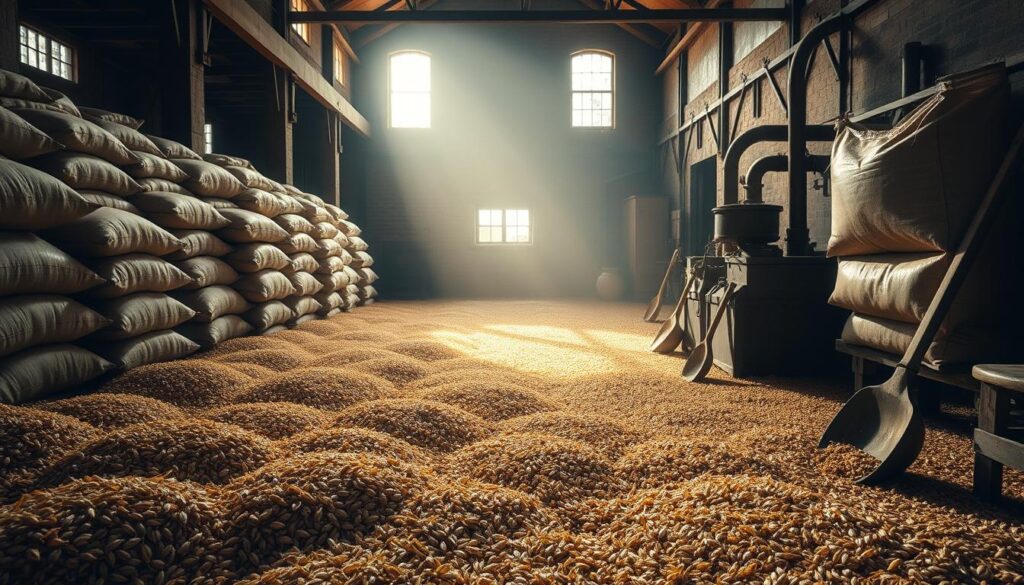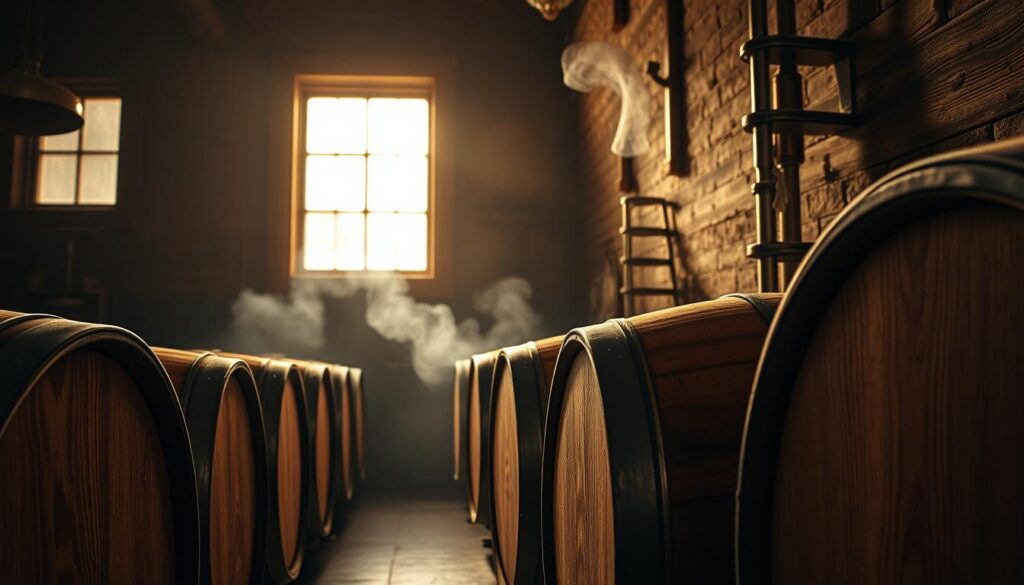The art of making whiskey has a long history, starting in Scotland in the 15th century. This shows the skill that goes into every whiskey bottle.
Scotland’s way of making single-malt whiskey is different from others. When you look into premium Scotch whisky essentials, you’ll see malted barley is at the heart of their method.
Different places spell whiskey differently. Scotland, Canada, and Japan use “whisky,” while America and Ireland prefer “whiskey.” Each place has its own rules to keep its whiskey unique.
Whiskey’s alcohol strength also varies. Most countries have it at 40%, but Australia allows 37%, and South Africa goes up to 43%. During America’s Prohibition, you could buy whiskey at pharmacies like Walgreens with a doctor’s note.
Curious to learn more about whiskey’s ingredients, production process, and unique global traditions? Read on to explore the full story!
The Essential Components of Whiskey Making
The foundation of whiskey lies in its three key ingredients: premium grains, pure water, and yeast. Each plays a crucial role in defining the whiskey’s character:
- Grains: The type of grain determines the flavor profile. Corn adds sweetness, rye contributes spice, and barley delivers malty richness. For instance, bourbon must use at least 51% corn, while single malt Scotch relies on 100% malted barley.
- Water: Pure water affects the whiskey’s flavor and is vital for mashing, fermentation, and dilution. Renowned distilleries like Ireland’s Midleton rely on local water sources to craft their signature whiskies.
- Yeast: This transforms sugars into alcohol during fermentation, producing unique flavor compounds.
Master distillers pay close attention to temperature, timing, and the right mix of ingredients. They use pure water to break down grains, aid in fermentation, and achieve the perfect strength for bottling. This careful focus ensures every bottle is of high quality.

What Is Whiskey Made Of: Understanding the Base Ingredients
The heart of every whiskey is its basic ingredients. Each sip tells a story of carefully chosen grains, pure water, and yeast. The perfect blend starts with premium grains, the core of any whiskey mash.
Corn adds natural sweetness and high alcohol, making it key for bourbon. Bourbon must have at least 51% corn. Barley brings rich, malty notes, adding depth. Many Irish distilleries, like those making traditional Irish whiskey, use both malted and unmalted barley.
The type of grain shapes the whiskey’s character. Rye adds bold, spicy notes and earthy undertones, while wheat makes the spirit smoother and creamier. The mash temperature is crucial to getting the most flavor from these grains.
Pure water is also vital. The Dungourney River supplies water to Ireland’s Midleton distillery, showing how place affects taste. Each grain undergoes careful processing before becoming part of the signature mash that defines great whiskey.
The Art of Grain Selection
Choosing the right whiskey grains is key to making great spirits. Master distillers carefully select from barley, corn, rye, and wheat, each contributing unique characteristics.
Corn, the star in bourbon, imparts sweetness and must make up at least 51% of the mix. Barley adds depth, rye brings spice, and wheat provides a subtle sweetness.
Distillers meticulously monitor grain quality for consistency, ensuring each batch delivers the intended flavor profile and avoids unwanted notes. Beyond taste, the combination of grains creates distinctive flavors, crafting special whiskey experiences.

The 5 Stages of Whiskey Production
Crafting whiskey is a meticulous journey that transforms raw ingredients into a refined spirit, brimming with flavor and character. Each stage of the process plays a vital role in shaping the final product. Here’s a closer look at the steps that take whiskey from humble grains to the bottle on your shelf.
1. The Malting Process
The whiskey malting process is the first step in making whiskey. It turns raw barley into malted barley through germination. The traditional method of whiskey production starts with soaking barley in water for two to three days.
Germination makes the grain develop enzymes. These enzymes convert starches into sugars that yeast can ferment. The distillers spread the grains on malting floors for about a week. Workers turn them to keep the temperature right and prevent clumps.
Then, the malted barley dries in a kiln at 70°C to stop germination. Some distilleries add peat to give whiskies their smoky flavor. Today, only eight distilleries, like Balvenie and Laphroaig, still malt their own barley. Most use modern methods for better quality.
After drying, the malted barley is ground. This creates a mix of husk, grit, and flour. These are key for the mashing process. The malting process’s control over temperature, moisture, and timing greatly affects the whiskey’s taste.
2. Mashing: Converting Grain to Sugar
The mashing process is crucial in whiskey making. Cooked grains, malted barley, and warm water mix at certain temperatures. This mix starts the grain conversion, thanks to enzymes.
Getting the temperature right is key. It starts at 150°F, where enzymes break down starches into simple sugars. Then, as it warms up to 160°F, another enzyme takes over, finishing the job. This makes the complex starches into sugars that yeast can eat.
Malted barley is essential in this step. It has enzymes that turn grain starches into sweet liquid. The size of barley starch granules, which come in two types, also matters. They affect how fast they break down.
The liquid from mashing, called wort, is full of sugars ready for yeast. Unlike beer, whiskey makers skip boiling after mashing. This keeps enzymes active, leading to more sugar conversion. This results in a richer, more complex whiskey.
3. Fermentation: Where Alcohol Begins
In fermentation, yeast converts grain sugars into alcohol. This process produces a liquid known as “distiller’s beer,” with 6% to 10% alcohol content, over 48 to 96 hours. Most distilleries now use stainless steel vats for durability and easy cleaning. However, some craft distilleries still opt for wooden vats to impart unique flavors.
Temperature control is critical during fermentation, with cooling systems ensuring optimal conditions. Yeast, comprising 2% to 2.5% of the mix, plays a significant role in flavor development. Different strains of yeast interact uniquely with the grains, influencing the final taste. On average, one ton of malt yields about 400 liters of alcohol.
4. Distillation Methods and Their Impact
Whiskey distillation turns fermented liquid into strong spirits using two main methods. The pot still method is traditional in Scottish and Irish distilleries. It creates rich, complex flavors through multiple distillation cycles.
The first run in a pot still changes the wash’s alcohol content. It goes from 8-10% to 20-25% alcohol in the low wines.
The column still method is different. It uses continuous distillation to reach alcohol levels up to 95% ABV. American whiskey producers often choose column stills for their efficiency and consistent output.
Copper stills are key in both methods for flavor development. The pot still process takes 4-7 hours for the first distillation. The second run lasts about eight hours.
This slower second distillation helps separate alcohol and flavor compounds from water. It creates the signature taste profiles we love in whiskey.
The choice between pot still and column still affects the final product’s character. Pot still whiskey often has fuller, more complex flavors, while column still spirits tend to be lighter and cleaner.
The resulting spirit usually reaches 60-70% ABV before dilution for aging. This careful balance of science and tradition shapes every bottle of whiskey we enjoy today.

5. The Magic of Maturation
The whiskey aging process turns raw spirit into a complex, flavorful drink. This journey happens in oak casks. Each cask adds its own special touches, making each whiskey unique.
The type of oak matters a lot. American oak gives vanilla and coconut flavors. European oak adds spicy, woody notes.
How long whiskey ages depends on its style and where distillers make it. Scotch whisky must age for at least three years in cool, wet places. American straight bourbon needs two years in the barrel. Some premium whiskies age for decades, up to 33 years.
Climate affects whiskey aging a lot. Warm places speed up the aging process. The size of the barrel also matters. Smaller barrels, like 50-liter octaves, age faster than bigger ones, like 500-liter butts.
Oak’s compounds, like cellulose and tannins, make whiskey special. The charred inside of barrels adds color and smoothness. This process makes each barrel unique, even when stored together.
Regional Variations in Whiskey Production
Whiskey types vary across the globe, each with its own production methods and flavors. Scotland’s whisky makers use malted barley and age it for at least three years in oak casks. This gives it a unique taste.
American whiskey has strict rules. Bourbon must be 51% corn, making it sweet and vanilla-like. Tennessee whiskey undergoes charcoal filtration before aging. Ireland’s triple distillation uses malted and unmalted barley for a lighter, fruitier taste.
In Japan, distilleries mix traditional Scottish methods with local water and aging environments. Canada’s whisky is mostly corn and wheat, often called rye whisky. The climate of each region affects how the whiskey matures.
These differences in production create distinct flavors. Scotch has smoky notes, while Irish whiskey is lighter. American bourbon is rich in vanilla and caramel, and Japanese whisky is clean and precise. These variations make whiskey a beloved and diverse spirit worldwide.
Final Thoughts: The Art and Essence of Whiskey-Making
Whiskey’s essence lies in its harmonious blend of grains, water, and time. While the core ingredients are simple, the craft of whiskey-making is anything but. Countless variables, such as grain selection, fermentation methods, distillation techniques, and barrel aging, contribute to its diverse expressions.
This intricate process highlights whiskey as more than just a drink — it’s a testament to tradition, innovation, and the pursuit of flavor perfection.
Understanding what goes into making whiskey is just the beginning of uncovering the secrets behind this iconic spirit.
Dive deeper into how Scotland’s pristine water sources and carefully selected grains contribute to the production of world-renowned whiskies. Centuries-old distillation techniques further refine these elements, creating the distinct characteristics that make Scotch whisky so revered.
Explore the stories, flavors, and traditions that make Scotch whisky truly exceptional at Scotland Whisky.